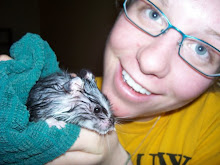
Sunday, March 11, 2012
Why I Love to Farm, Part IV

Why I Love to Farm, Part III
 Haha, just you try to keep me from throwing myself into the lethal depths, I dare ya
Haha, just you try to keep me from throwing myself into the lethal depths, I dare ya Sunday, March 4, 2012
My weird diet

Friday, March 2, 2012
Wilbur is showing himself to be of the "gathering" variety of stock dogs, rather than the "driving" type, which is not a surprise for a Border Collie. He likes to run out in front of the pigs, and gets extra exuberant when a member of the herd darts off in a new direction. He's definitely due for some formal herding training as this isn't entirely helpful, and we're getting closer to a point where stock dog training is a possibility. You can't start them on herding until their obedience is solid. It'd be like skipping counting and going straight to multiplication. Hopefully he has more talent for herding than I do for multiplication!
His recall has gotten a lot better in the past few weeks - something just seemed to click one day while we were practicing, and he was suddenly really excited to show me his come. His stay is finally progressing now that I've added a long stay to his meal time routine. He's much more committed to obedience when there's a whole dinner on the line! One thing we need to figure out is the "stand" command which should freeze him mid-run. Wilbur does not excel at stillness! Perhaps I need to carry around his dinner bowl while we practice :) Wilbur is young and goofy and has quite a rookie for a trainer, but he's got a very solid brain and the sweetest disposition imaginable. How did I get so lucky with the world's best cats and dogs?!
Thursday, March 1, 2012
Speaking of which, my grain sprouting experiment is going smoothly, and I've completely transitioned the goats off their commercial diet and onto sprouted whole grains and seeds, bran mash, and brewer's grains. It's certainly more labor intensive than just popping open a feed bag and scooping away, but so far it's very satisfying to feed some healthy green material in the dead of winter. The chickens love it, but I'm only producing enough for them to get a gallon or so a day - just a snack for a hundred busy laying hens!
I've been finally getting down to business with culling and labeling the laying flock, but gave up on the seemingly much more efficient physical exam method. There is a lot of info on the web and in books explaining how to determine if a hen is laying efficiently or is old and ready to retire. The tell tale signs include a darkly pigmented beak and legs, narrow and stiff pelvic bones, small and pale comb, and gross/shrively/dry vent (as opposed to gross/wrinkly/moist vent, ew). Unfortunately, with every breed of chicken under the sun ranging in age from 7 months to 7 yrs, it was comparing apples and oranges. A barred rock is going to have a lot more pigment everywhere than a white leghorn, pelvic bone width is very dependant on the breed's size and shape, and the difference between an egg laying vent and a plain old pooping vent isn't very obvious.
I killed a good ten or twelve chickens, convinced that they were old and useless, only to find a bunch of eggs lining up to be laid. So, feeling much too guilty to continue the guessing game, even though those layers were probably not efficient layers, I've started separating small groups of birds and just waiting to see if they lay. I'm trying to get a white, green, and brown egg layer all in the test group at once to speed things up because I have a good sixty or seventy birds to work through. I tried a large white and small white bird the first time, but ended up with a medium white egg, and both birds sitting on it looking business-like now and then! I'm also banding birds I see in the hen house a lot if I notice them laying an egg. It's not a perfect system, and we're still going to have a few duds in the bunch, but it's progress towards a more efficient farm and a big learning experience as well!
Saturday, January 21, 2012
Why I love to farm, Part II

Thursday, January 19, 2012
Well, as long as you asked...
Farming is a natural evolution of my first career in animal welfare. Instead of making life a bit more tolerable for animals in humane societies, I now get to foster partnerships between livestock and the local ecosystem that improve the land's resiliancy while giving the animals fulfilling lives. I love the daily opportunities for creativity and innovation and am so grateful for the strong bonds that quickly form between new and experienced farmers in our local agricultural community. My schedule and duties are never predictable, giving me an incredible freedom to take advantage of perfect afternoon running weather and yet a deep sense of responsibility to meet the needs of the livestock at any hour (and they do like the midnight hour for their urgent needs!). Accomplishments are measured on both a much larger and a much smaller scale than in our mainstream society, continually keeping me both challenged and satisfied. Most importantly, I don't have to leave my dog sitting at home as I trudge off to another day on the job, but open the door each morning to a calling that is hardly a job at all, with coworkers who only wear carhardts and smiles, and many more who sport suits of fur and feathers. This type of farming is a dynamic, frustrating, loving, co-dependant relationship - though I couldn't tell you if the farmer is the parent or the child.

